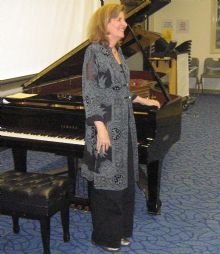|
Symphony
FROM THE NEW WORLD TO THE OLD WORLD
by Peter Lert
Saturday, June 14, 2025
Chamber
MC2 DUO RECITAL CLOSES 222'S SEASON
by Terry McNeill
Saturday, June 14, 2025
Choral and Vocal
CANTIAMO SONOMA'S LUSCIOUS A CAPELLA SINGING IN SEASON ENDING CONCERT
by Pamela Hicks Gailey
Sunday, June 8, 2025
Symphony
SRS SEASON ENDS WITH RESOUNDING TA-TA-TA-BANG
by Terry McNeill
Sunday, June 1, 2025
Symphony
YOUTHFUL VIRTUOSITY ON DISPLAY AT USO'S MAY CONCERTS
by Peter Lert
Saturday, May 17, 2025
Symphony
MYSTICAL PLANETS AND LIVELY GERSHWIN ORTIZ AT FINAL SRS CONCERT
by Peter Lert
Sunday, May 4, 2025
Symphony
VSO'S CONCERT MUSIC OF TIME, MUSIC OF PLACE
by Peter Lert
Sunday, April 27, 2025
VOCAL ELEGANCE AND FIRE AT THE 222'S RECITAL APRIL 26
by Pamela Hicks Gailey
Saturday, April 26, 2025
CANTIAMO SONOMA SINGS AN INSPIRED GOOD FRIDAY MOZART REQUIEM CONCERT
by Pamela Hicks Gailey
Friday, April 18, 2025
DRAMATIC SHOSTAKOVICH SYMPHONY CLOSES PHILHARMONIC'S 25TH SEASON
by Terry McNeill
Sunday, April 13, 2025
|
 |
 Carolyn Steinbuck Receiving Recital Applause at Mendocino College |
STEINBUCK'S MASTERY DAMPENS RAINY DAY GLOOM IN LYRICAL UKIAH RECITAL
by Terry McNeill
Sunday, October 24, 2010
Schubert’s Piano Sonatas often receive a mixed audience reaction, despite their craftsmanship, sunny tunes and drama. When all the repeats are played, and sections morph into more sections, to some they can seem wandering and overly extended. But not to seasoned musicians, as the prolongation is a heavenly length.
It was this blessed length that pianist Carolyn Steinbuck found Oct. 24 in a Mendocino College recital, the second in the Concerts Grand season. Schubert’s A Major Sonata, D. 959, constituted the entire second half and received a careful and attentive reading, the opening Allegro solemn with controlled passagework. The development section had sharp contrasts and Ms. Steinbuck played off the forte dissonances. The concluding slow set of arpeggios at the end would stand comparison with Schnabel’s famous recording from the 1930s. Praise can go no higher. The second movement, Andantino, was played at the beginning as a barcarolle and then became improvisatory and moved to a stirring climax. This movement is difficult to bring off but the pianist did it well, often with half pedal effects.
The Scherzo was played in a properly playful manner, marred only by muddy scales passages. The concluding Rondo-Allegretto is indeed lengthy with many meandering themes, and the pianist tousled with the movement but never lost sight of Schubert’s “endless songful melody.” Anton Rubinstein called the composer “eternal sunshine in music” and Ms. Steinbuck found bountiful lyricism, managing the relentless modulations well and keeping the movement’s momentum intact. The agitation of the last few bars was forcefully achieved.
The concert opened with a surprise beginning work, Poulenc’s Toccata from Trois Pièces, and the pianist’s jazzy sforzandos and rapid repeated-note passages quickly opened the ears of the 71 in the College’s Choral Room. The playing conveyed the Poulenc’s restlessness and brilliance, the tonality never quite certain.
Debussy’s three “Estampes” came next, two musical imaginings of East Asia and Spain, and the “Jardins sous la Pluie,” a French garden in the rain that under Ms. Steinbuck’s masterly fingers and feet reflected the deluge going on outside the hall. “Soirée dans Granade”, a work with a habanera rhythm, was effectively played and the tempo not rushed, lacking only crisp articulation in the right-hand passages that exemplify the potent dance rhythms and tonal “growls” in the bass. Ms. Steinbuck’s deft pedal technique and gamelan effects made “Pagodes” seem exotic and almost luminescent.
Preceding intermission Beethoven’s A-Flat Major Sonata was performed, the noble opening theme played with restraint and in uniform tempo. In the Allegro molto the right-hand figurations in the central section were never hurried. In the concluding Fuga Ms. Steinbuck underscored the counterpoint and gave a structurally cogent version of the short aria that interrupts the increasing impetuousness of the fugue subject. At the finish, a descending and ascending phrase led to a single chord, with no fermata, widely spaced in the hands and of intense emotional power. It was playing of aristocratic temperament, doing full justice to Beethoven’s exalted vision.
One encore by the artist was offered, Piazzola’s “Song of the Angel.” It was a performance without the vitality of the Schubert but offering instead the saturated tango colors and languor characteristic of the Argentine master’s genius in small forms. The audience went back into the Ukiah rain in a peaceful mood.
The reviewer is the producer for the Concerts Grand recitals
|

